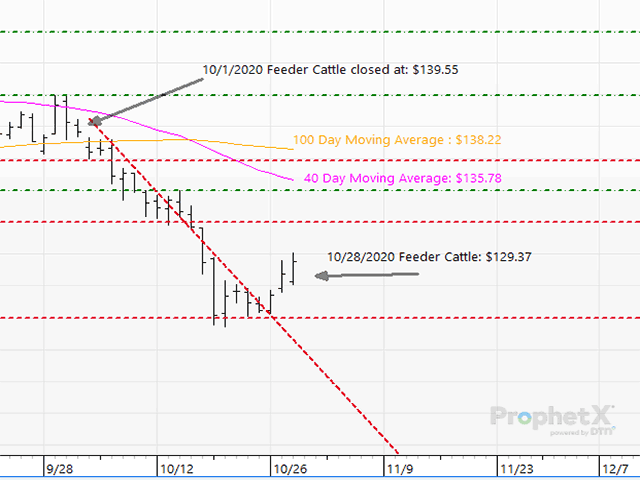Call the Market
There's a Time to Plan and a Time to Rethink
Last year at this time, cattlemen were looking at a completely different feeder cattle market. Following the packing plant fire in Holcomb, Kansas, the fall feeder-cattle run was slow to start as cattle prices crumbled. But as we moved into October, the cattle market had ample support.
By the middle of October 2019, the live cattle market had a successful $17.60 rally over 36 days and was well above the 40-day ($103.06) and 100-day ($105.74) moving averages at $111. Because of the fruitful rally in live cattle, feeder cattle were absorbing some of the live cattle market's energy. Though feeder cattle prices weren't anything producers were going to get rich on, they relished the fact that the market had a strong undertone and was well supported, giving producers the confidence they needed to market their calves.
Fast forward to the fall of 2020. While the live cattle market dances relatively close to where prices were just over a year ago, the market's tone and demeanor are completely different. On Oct. 1, the live cattle market closed at $111.82. As of Oct. 27, the market has fallen $7.77 over the last 27 days to $104.05, falling well below the market's 40-day moving average ($109.72) and 100-day moving average ($108.74).
P[L1] D[0x0] M[300x250] OOP[F] ADUNIT[] T[]
Though live cattle and feeder cattle are two separate markets, they tend to walk hand in hand; strength in one market can easily be absorbed by the other. That is especially true when it comes time to market calves and feeder cattle, as cattle buyers are meticulously looking at their breakevens, monitoring initial expense (the purchase of the calf) and input costs (feed, labor, yardage and trucking), and gauging a desired output price (live cattle price).
Consequently, feeder cattle prices have weakened through the month of October. With corn prices dancing awfully close to $4.20 per bushel, live cattle prices are scaling lower, and as supply outweighs demand throughout the countryside, the odds have been stacked against the feeder cattle market.
When it comes to marketing feeder cattle, you'll often hear market specialists talk about the importance of consistency. If, analytically, you've done your homework and found a time in the market when prices usually favor sellers, being consistent in your marketing strategy can pay dividends over time (the key being over time).
There are times when the market all but flashes red lights and begs producers to sell. At this point, however, producers are probably better off stepping back, reevaluating the marketplace and potentially selling at another time.
If there's one thing we all have learned this year, it's that, in our day-to-day lives, in our working environments and in our businesses, we've got to be flexible. Having a marketing plan is vital! I cannot stress enough the importance of being active and informed participants within the marketplace. But that also means being willing to adapt as situations arise.
ShayLe Stewart can be reached at ShayLe.Stewart@dtn.com
(c) Copyright 2020 DTN, LLC. All rights reserved.




